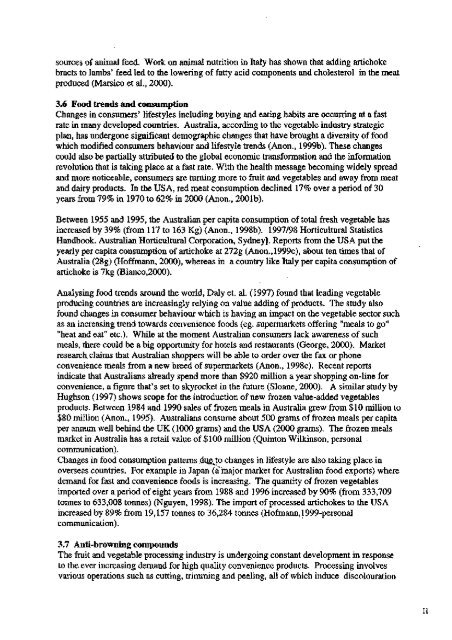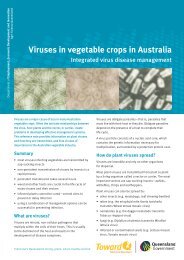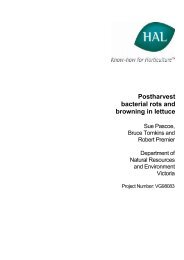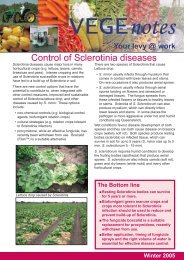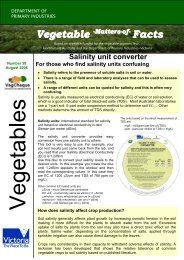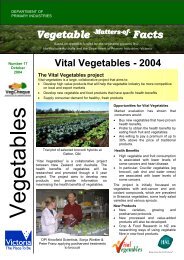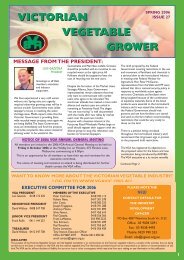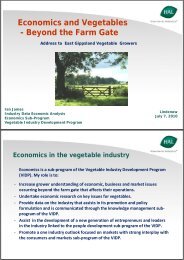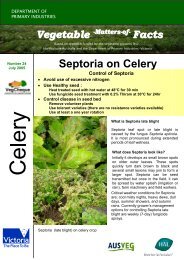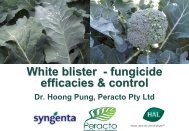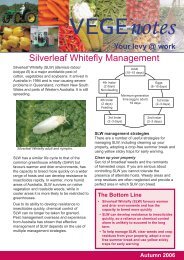Developing strategies to stimulate local consumption, export and ...
Developing strategies to stimulate local consumption, export and ...
Developing strategies to stimulate local consumption, export and ...
You also want an ePaper? Increase the reach of your titles
YUMPU automatically turns print PDFs into web optimized ePapers that Google loves.
sources of animal feed. Work on animal nutrition in Italy has shown that adding artichokebracts <strong>to</strong> lambs' feed led <strong>to</strong> the lowering of fatty acid components <strong>and</strong> cholesterol in the meatproduced (Marsico et al., 2000).3.6 Food trends <strong>and</strong> <strong>consumption</strong>Changes in consumers' lifestyles including buying <strong>and</strong> eating habits are occurring at a fastrate in many developed countries. Australia, according <strong>to</strong> the vegetable industry strategicplan, has undergone significant demographic changes that have brought a diversity of foodwhich modified consumers behaviour <strong>and</strong> lifestyle trends (Anon., 1999b). These changescould also be partially attributed <strong>to</strong> the global economic transformation <strong>and</strong> the informationrevolution that is taking place at a fast rate. With the health message becoming widely spread<strong>and</strong> more noticeable, consumers are turning more <strong>to</strong> fruit <strong>and</strong> vegetables <strong>and</strong> away from meat<strong>and</strong> dairy products. In the USA, red meat <strong>consumption</strong> declined 17% over a period of 30years from 79% in 1970 <strong>to</strong> 62% in 2000 (Anon., 2001b).Between 1955 <strong>and</strong> 1995, the Australian per capita <strong>consumption</strong> of <strong>to</strong>tal fresh vegetable hasincreased by 39% (from 117 <strong>to</strong> 163 Kg) (Anon., 1998b). 1997/98 Horticultural StatisticsH<strong>and</strong>book. Australian Horticultural Corporation, Sydney]. Reports from the USA put theyearly per capita <strong>consumption</strong> of artichoke at 272g (Anon.,1999c), about ten times that ofAustralia (28g) (Hoffmann, 2000), whereas in a country like Italy per capita <strong>consumption</strong> ofartichoke is 7kg (Bianco,2000).Analysing food trends around the world, Daly et. al. (1997) found that leading vegetableproducing countries are increasingly relying on value adding of products. The study alsofound changes in consumer behaviour which is having an impact on the vegetable sec<strong>to</strong>r suchas an increasing trend <strong>to</strong>wards convenience foods (eg. supermarkets offering "meals <strong>to</strong> go""heat <strong>and</strong> eat" etc.). While at the moment Australian consumers lack awareness of suchmeals, there could be a big opportunity for hotels <strong>and</strong> restaurants (George, 2000). Marketresearch claims that Australian shoppers will be able <strong>to</strong> order over the fax or phoneconvenience meals from a new breed of supermarkets (Anon., 1998c). Recent reportsindicate that Australians already spend more than $920 million a year shopping on-line forconvenience, a figure that's set <strong>to</strong> skyrocket in the future (Sloane, 2000). A similar study byHughson (1997) shows scope for the introduction of new frozen value-added vegetablesproducts. Between 1984 <strong>and</strong> 1990 sales of frozen meals in Australia grew from $10 million <strong>to</strong>$80 million (Anon., 1995). Australians consume about 500 grams of frozen meals per capitaper annum well behind the UK (1000 grams) <strong>and</strong> the USA (2000 grams). The frozen mealsmarket in Australia has a retail value of $100 million (Quin<strong>to</strong>n Wilkinson, personalcommunication).Changes in food <strong>consumption</strong> patterns duet<strong>to</strong> changes in lifestyle are also taking place inoverseas countries. For example in Japan (aTmajor market for Australian food <strong>export</strong>s) wheredem<strong>and</strong> for fast <strong>and</strong> convenience foods is increasing. The quantity of frozen vegetablesimported over a,period of eight years from 1988 <strong>and</strong> 1996 increased by 90% (from 333,709<strong>to</strong>nnes <strong>to</strong> 633,008 <strong>to</strong>nnes) (Nguyen, 1998). The import of processed artichokes <strong>to</strong> the USAincreased by 89% from 19,157 <strong>to</strong>nnes <strong>to</strong> 36,284 <strong>to</strong>nnes (Hofmann,1999-personalcommunication).3.7 Anti-browning compoundsThe fruit <strong>and</strong> vegetable processing industry is undergoing constant development in response<strong>to</strong> the ever increasing dem<strong>and</strong> for high quality convenience products. Processing involvesvarious operations such as cutting, ttimming <strong>and</strong> peeling, all of which induce discolouration11


